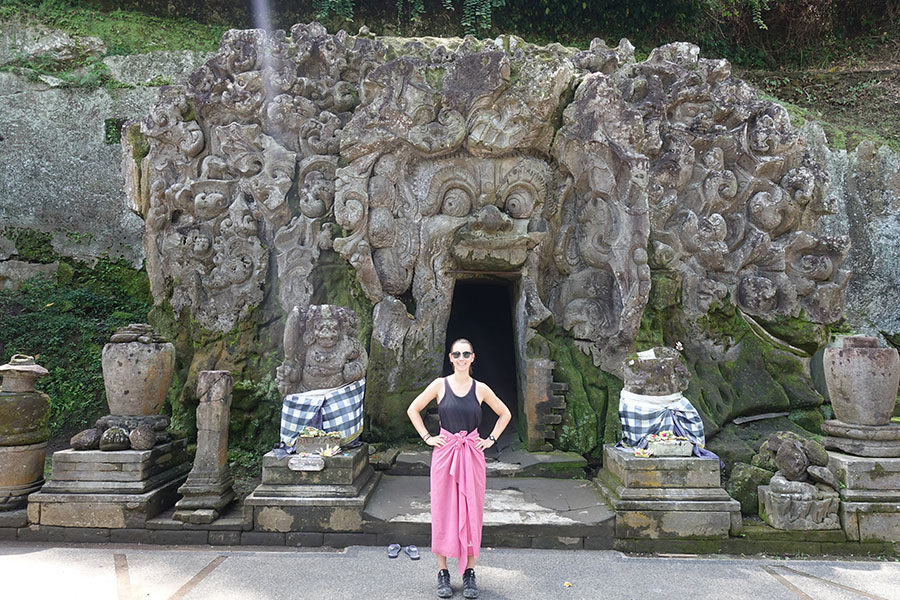BALI GOA GAJAH TEMPLE
GOA GAJAH TEMPLE BALI IS A HISTORICAL SITE THAT FOUND RELIC ABOUT ACCULTURATION TWO RELIGION BUDDHIST AND HINDU SHIVA

Welcome to Goa Gajah Bali Temple or Elephant Cave Temple, located on the western side of the countryside Blahbatuh Sub-district, Gianyar Regency. The temple is about 27 kilometers from the city of Denpasar. The cave is built on the edge of a ravine between two tributaries, the Pangkung River and the Petanu River, which come together in an area called Campuhan, or Mixed. The concept of Rwabineda, or two different things, became the basis of the construction of Goa Gajah Temple, which confronts the magical power of the fusion of the two rivers. This temple is very interesting to visit because you can learn about the history of the development of Hinduism in Bali as well as see historical relics such as statues and sites that have high value in the history of the island of Bali. The cool and cozy atmosphere around the river adds to the strong religious impression of this place.
If you visit Goa Gajah Temple, here’s what you need to know :
- Goa Gajah Location
- Goa Gajah History
- Meaning Name Goa Gajah
- Relic Budha Statue
- Goa Gajah Temple Geographically
- Goa Gajah Dress Code
Goa Gajah Location
Gua Gajah, located in Betulu Village, Blahbatuh District, Gianyar Regency, is one of the Gianyar places of interest that has become a very popular tourist destination among tourists. From Kuta, the trip will take about 1 hour and 30 minutes, while from Ubud, it will take about 30-45 minutes by car or motorcycle. The location is quite easy to find as it is in a bustling tourism area, with road signs at every intersection pointing the way to Goa Gajah Temple. If you have trouble finding the location, you can use Google Maps to help you reach your destination. If you don’t want to bother driving yourself, we from Bali Exotic Tour provide Hire Car and Driver services at affordable prices and satisfying services. It is supported by experienced and friendly drivers, which makes your trip even more enjoyable. Besides visiting Goa Gajah, you can also explore other places, such as Tegenungan Waterfall, around this location. If you are on vacation in Bali, don’t miss the opportunity to visit Goa Gajah and admire the uniqueness of this site, including the elephant carvings on the cave walls.
Goa Gajah History
Based on history, Goa Gajah Temple was built in the period of 10-11 AD, when the Warmadewa royal dynasty was in power. The name “Goa Gajah” refers to the Ganesha statue carved into the cave wall. In 1923, the Goa Gajah site was discovered by L.C. Heyting, who found Ganesha statues, Tri Langga statues, and Hariti statues. Further research was conducted by Dr. W.F. Stutterhiem in 1925, and in 1950, research was expanded by the Indonesian side, including the Indonesian archaeological side, from 1954 to 1979. This research revealed a small pool in front of the cave mouth, equipped with six female statues and a water fountain. The water from this shower is believed to prolong the lives of visitors who drink it. This discovery reveals the beliefs of ancient times, where statues such as Ganesha represented gods in Hinduism, and the spread of the religion was already happening at that time.
Meaning Name Goa Gajah
The word “Goa Gajah” is thought to be derived from “Lwa Gajah”, which is the name of a Buddhist temple or hermitage of Buddhist monks. The name “Goa Gajah” was first recorded in the Negara Kertagama papyrus, written by Mpu Prapanca in 1365 AD. “Lwa” or “Lwah/Loh” means river, indicating that the hermitage was located in the vicinity of the Gajah River or Air Gajah. In the inscription of 944 Saka, the name is mentioned as’ser ring Air Gajah’, indicating subak leadership in the Air Gajah area. The inscription also mentions that the Lwa Gajah hermitage is located in Subak Air Gajah. Among the locals, Goa Gajah Temple is often referred to as Goa Temple, which is located in the west of Bedahulu Village, Blahbatuh District, Gianyar Regency. The temple is about 27 kilometers to the east of Denpasar. Access to this temple is very easy, as it is located just a few meters below the highway to Tampaksiring Village. The temple is built in the Petanu River valley, which offers a beautiful natural panorama.
Relic Budha Statue
In addition to lightning and caves, the Goa Gajah site also contains ancient remains in the ruins of a cliff to the southeast identified as the Tukad Pangkung complex. To make it easier for visitors to reach this complex, concrete stairs and a bridge across Tukad Pangkung have been built. From the bridge, stairs are made to reach the Buddha statue fragments located on a higher cliff. Before crossing the bridge, there are stairs to view other carved fragments and an ascetic niche.
The overall structure of Goa Gajah Temple is different from other temples in Bali, which generally consist of Jaba, or outer courtyard, Jaba Tengah, or middle courtyard; and Jeroan, or backyard, which is the most sacred place in a temple. With a cool atmosphere and making the adventure more religious, it is a pleasure to visit this historical site and see the relics of two faiths, namely Shiva Hinduism and Buddhism, in one place. Based on iconographic studies of the Trilingga, Ganesha, Shower, Ganesha, and lightning statues, Goa Gajah is thought to have been founded in the 11th century AD, during the reign of Anak Wungsu. However, looking at Buddhist relics such as the Dyani Buddha Amitaba statue, which is similar in style to the Dyani Buddha statue in Borobudur Temple dating from the mid-9th century AD, it can be concluded that Goa Gajah probably existed long before the reign of Anak Wungsu, initially as a Buddhist shrine, and it was not until the 11th century AD that Hinduism also built a shrine complex here.
Goa Gajah Temple Geographically
If you are visiting Goa Gajah, it is important to know the layout of this precious site so that you don’t get confused during your visit. At Goa Gajah, you’ll find buildings and relics that reflect both Hindu and Buddhist cultures. In the past, this place was occupied by Buddhist monks who interacted with Hindu priests, exchanging ideas about Buddhism and Hinduism. Both teachings are now the roots of Hinduism on Bali Island.
- To the north of the temple, there is a natural cave in the shape of the letter “T”, with carvings in the shape of human faces beautifully carved into the rock inside. Some parts of the carvings have been eroded by time. Inside the cave, there is a Ganesha statue revered as the god of knowledge, located at the end of the cave and considered sacred by the locals. In addition, there are also fragments of statues and the Trilangga, which is surrounded by eight small phalluses, which are part of the Shiva Hindu belief.
- On the walls of the cave, there are ascetic niches, and the face of the cave is decorated with carvings depicting the forest and its contents. There are also short inscriptions with the words “Kumon” and “Sahywangsa”, which are thought to date from the 11th century AD based on the typeface. To the west of the cave, there is a building that houses a squatting statue, a Ganesha statue, and a Men Brayut statue. Men Brayut, in Buddhist mythology, is known as Hariti, who protects children. This relic of Buddhism is very beautiful and exudes serenity when looking at it.
- In front of the cave, apart from the guardian statues, there are also fragments of buildings of unknown origin, such as the fragments of buildings now collected in the temple courtyard to the west of the bathing pool. The re-functioning fountain statues in the bathing pool are divided into three parts, and from their style, they probably date back to the 11th century AD. However, the statue fountain in the center of the pool has not been found to date. At Goa Gajah Temple, there are two Buddha statues, one headless and the other in fairly good condition in the Central Javanese style. The north side of the statue seems to be attached to the cliff, where the foot of the cliff temple has fallen into the river. On this small side, there is a relief of a three-pronged stupa and the ruins of a cliff temple decorated with beautiful carvings.
Goa Gajah Dress Code
Based on the archaeological findings mentioned earlier, Goa Gajah Temple can be dated back to the 9th to 11th centuries AD. In the past, this temple served as a monastery for Buddhist monks and Shiva priests. This fact shows that the integration between Buddhism and Shiva went well at that time. When visiting Goa Gajah, it is advisable to dress modestly, as this is a historical site that is respected by the local community. You will be given a sarong and shawl by the attendant, usually as a package with the entrance ticket. Please preserve this site, as it is very old. The experience here can leave a lasting impression, as you can see the fusion of Hindu and Buddhist influences in a natural setting, creating an impressive atmosphere. If you love history and unique things, Goa Gajah is a must-visit destination.

